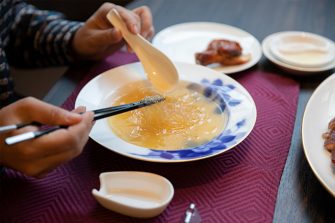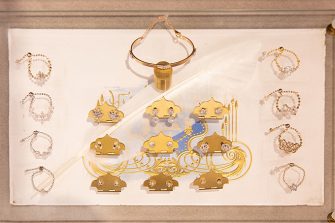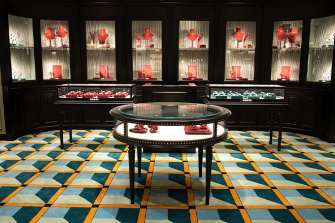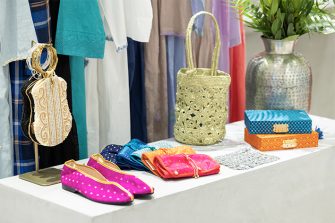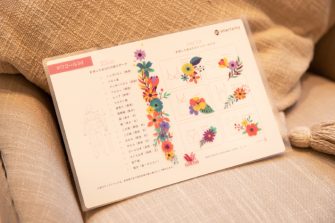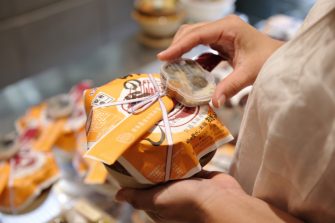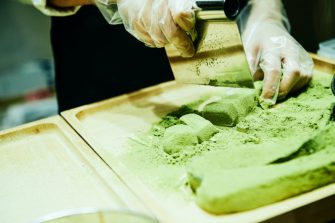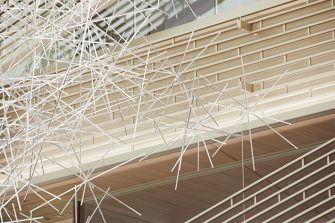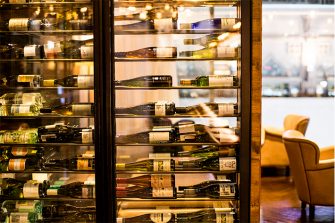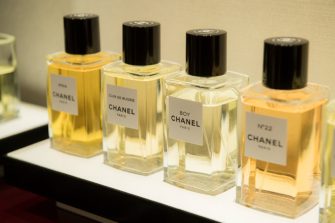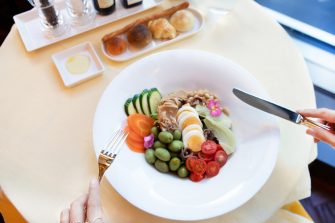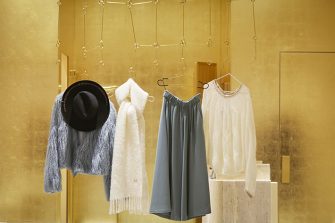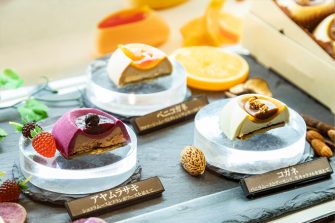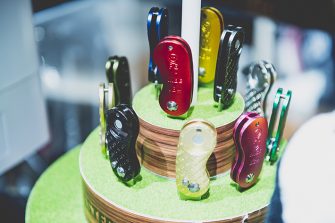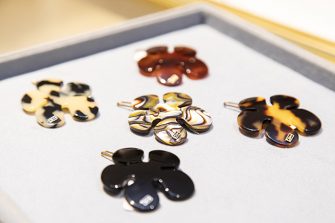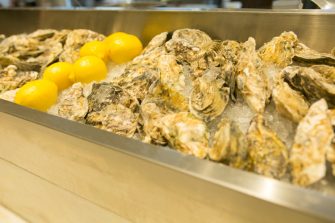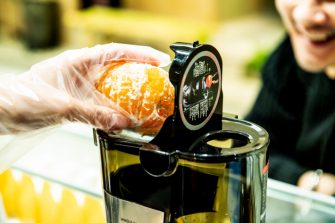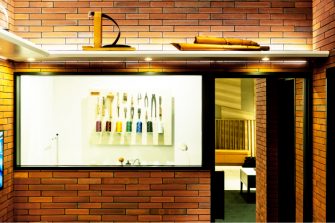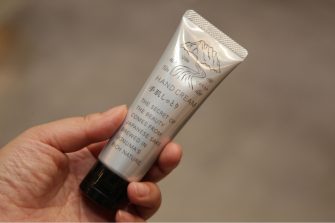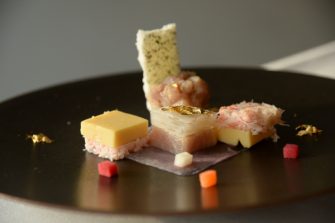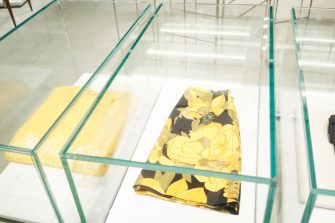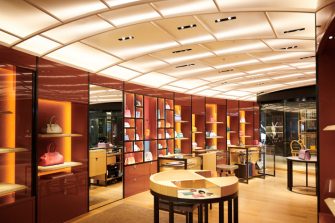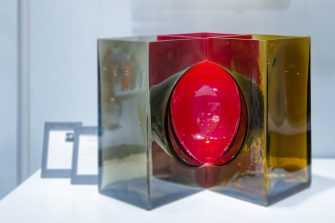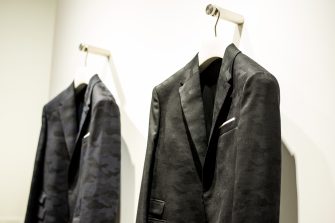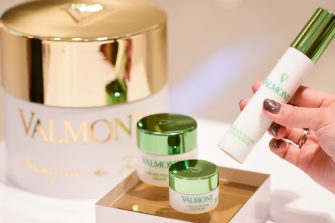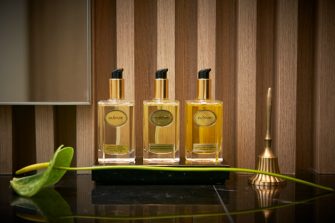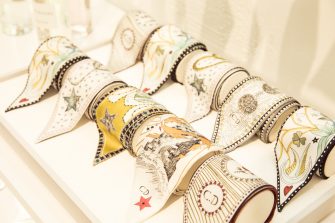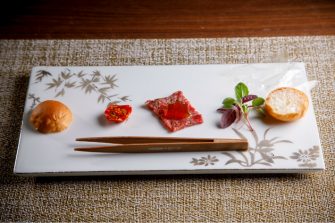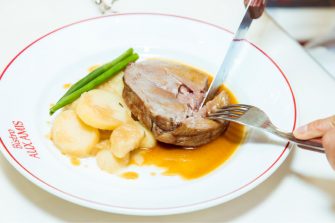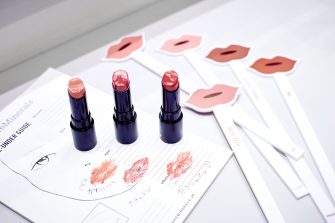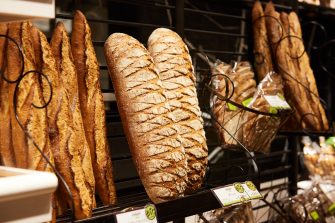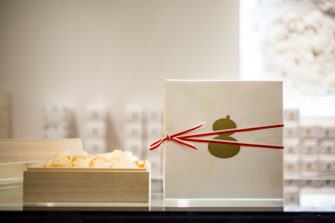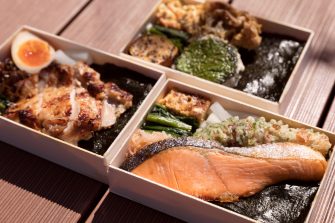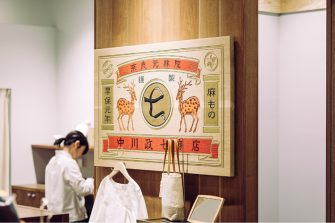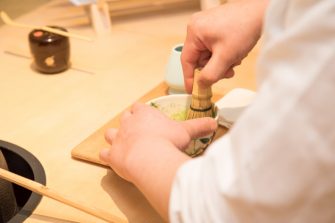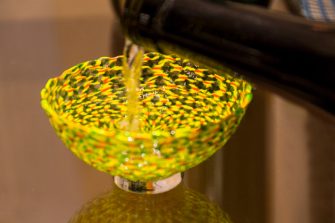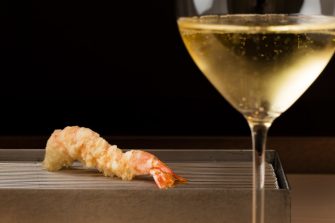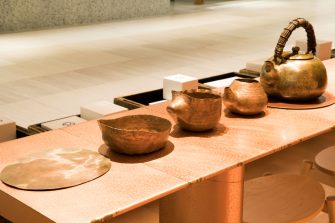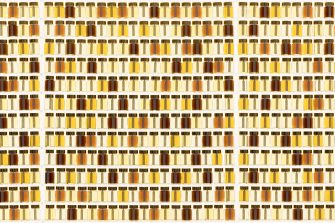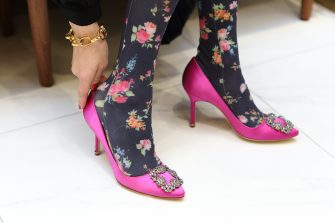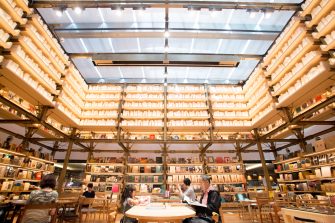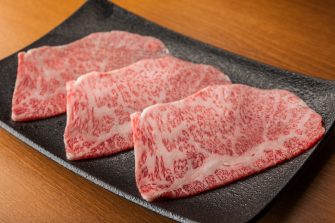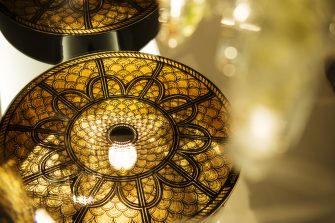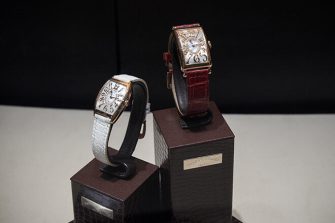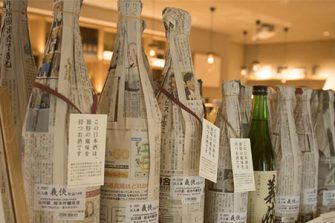

GINZA SIX EDITORS
ファッション、ジュエリー&ウォッチ、ライフスタイル、ビューティ、フード…
各ジャンルに精通する個性豊かなエディターたちが、GINZA SIXをぶらぶらと
歩いて見つけた楽しみ方を綴ります。
銀座の真ん中で密やかに、自由に。散歩と一人飲み A Quiet Spree in Mid-Ginza: A Walk and a Few Drinks Alone
寒河江 千代
GINZA SIX EDITORS Vol.53
東京の街にもっとベンチを! 年に数度帰国する度にそう思う。ひと休みしたり、行先のアドレスを確かめたり。理由はともあれ、世界の都市のベンチに腰掛ければ、行き交う人のリズムや表情が見えてくる。ひとときのベンチタイムは、今いる街と人の在り様をほんの少し客観的に見せてくれるし、と同時に身近に感じさせるから不思議だ。ベンチは、無料であらゆる人に開かれた“小さな街のオアシス”なのに、と。
前置きが長くなってしまったが、GINZA SIX で最初に惹きつけられたのは、館内の多数のベンチだった。各フロアの(多くは吹き抜け空間を囲む)通路に革張りで幅広のちょっと贅沢なベンチがある。そこで買い物の相談をするカップルやひと休みする年配の女性の姿は、街角の自然な風景を見るようだ。私も座り、視線を低くして眺めれば、通路や店舗が一直線に区切られず、店舗ブロックの角も直角でなく、先へ先へと人を誘う路地のような館内のレイアウトに気づかされる。居心地の良さはこんなところにも潜んでいた。
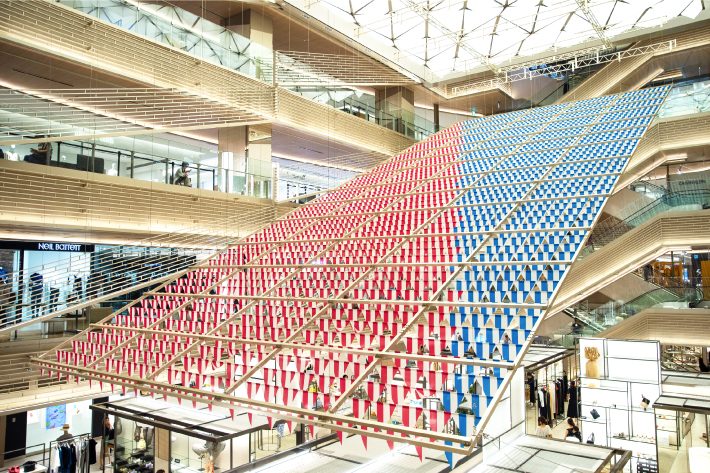
GINZA SIX の散歩の楽しみはベンチのみに非ず。今年の春、館内中央の吹き抜け空間に現れたフランスの現代美術家ダニエル・ビュレンの作品『ムクドリの飛行のように』もその一つ。以前にパリで取材をした際に「場所や空間の特性を作品に取り込む私の原点は、日本の“借景”」と小さくウインクした巨匠のチャーミングな笑顔を思い出す。観る者に自由な発見を託す氏の作品は「さあ、あなたはどう観る?」と問いかけてくる。角度や方向を変えて眺めれば、様々な表情を見せてくれるに違いない。
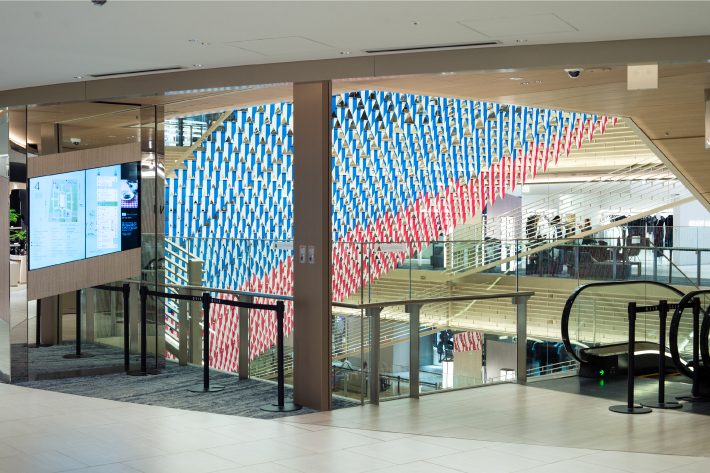
吹き抜けの空間に、赤と青のストライプの三角旗全1,675枚を垂らした巨大な長方形のフレームを斜めに設置した作品は、そのエアリーな斜面を途中階から眺めれば、階下で見上げた時とはまた一味違う表情に。見る位置や角度により、全体のボリューム感や形状、赤と青の割合が変化し、異なる印象を与えるから面白い。

大空を旋回するムクドリの編隊をフランスの田舎の広大な草地で見かけたことがある。一瞬にして翻り、伸縮を繰り返す群舞のようなムーブメントを「もしも、空の上で間近に見たらこんな感じ?」想像が膨らむ。こうしていると、空に近い大きな空間で無性に深呼吸したくなる。そんな時には GINZA SIX 自慢の屋上庭園「GINZA SIX ガーデン」へ!
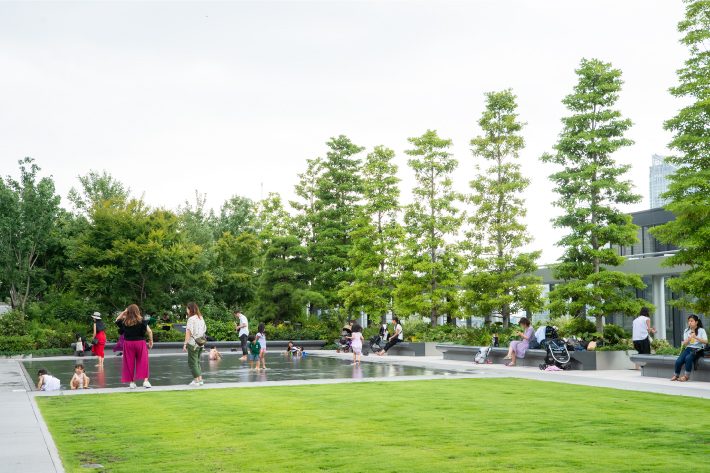
開館から1年を経た夏、芝も樹木もしっかり根付き、緑濃く茂る屋上庭園。敷き詰めた石板に水を流す水盤は小さな子供達に大人気。

中央の広場は空に開け、銀座の街路やビルをながめ渡す遊歩道は広大な屋上のぐるりと囲む。さらに、広場の脇には高低の灌木を配す緑の小道が現れて、地上数10メートルの屋上にいることを忘れさせ、散策や読書、木陰でランチと、好きな場所で誰もが思い思いの時間を過ごす。「緑はもちろん、人も生き生きと呼吸する空の土地になってくれたら」と語ったランドスケープアーキテクト、宮城俊作氏の庭園設計の細やかさに得心が行く。
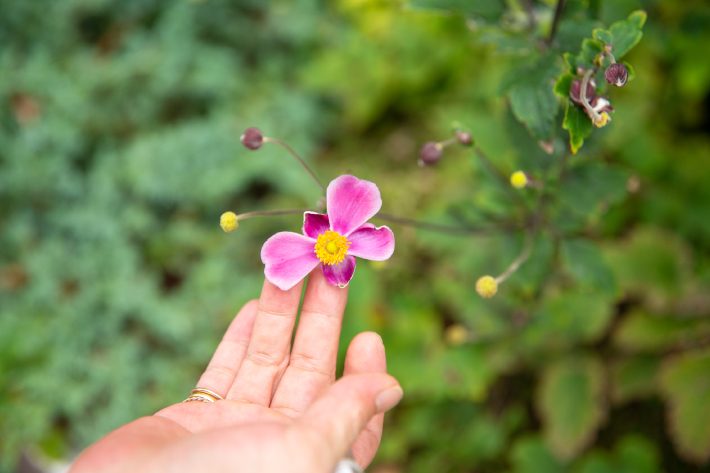
明治初期、日本に初めて現れた銀座の街路樹は、桜や紅葉の美しい日本古来の樹木でまかなわれたという。そんな歴史を背景に、屋上庭園の樹木、草花は全て日本の在来種で構成される。「和」の際立つ日本庭園以外で、在来種のみの庭は極めて稀だ。植物に疎い私は、目にする小花の一つ一つに学ぶ思い(立て看板によると「イヌマキ」の花)。

ベンチのデザインも気になります。膝の当たる部分が曲線を描く座り心地の優しいデザイン。木、灰色の御影石や黄褐色の石など、同デザインで素材の異なるベンチが庭園内に多数!

さらなる散歩の楽しみは、夕刻ならばふらり一人で立ち寄るアペリティフ。とはいえ、夕食の予約なしに、ワイン1杯で立ち去っても気兼ねのない個人店が意外に少ない、東京。長年暮らすパリには名もなきカフェがどの地域にも山ほどあり、カウンターやテラスでその夜の予定を立てることもしばしば。この、束縛のない自由なひとときを求めて、地下2階の「ワインショップ・エノテカ」のカフェ&バーへ。
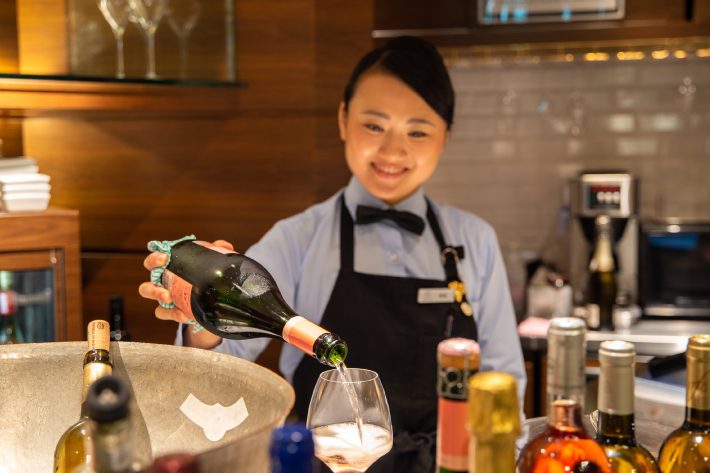
ショップへ続く通路がそのまま店空間という気の置けなさが、まず特筆。グラスワインリストを覗けば(スパークリングを含む)充実の7種が500円から始まるのも魅力的だ。「毎週水曜に一新します」と、ソムリエでワインセレクターの赤坂宜映さんが注いでくれる辛口のスパークリング(スペインのカヴァ)の、爽やかで深みのある味わいに気持ちが弾む。
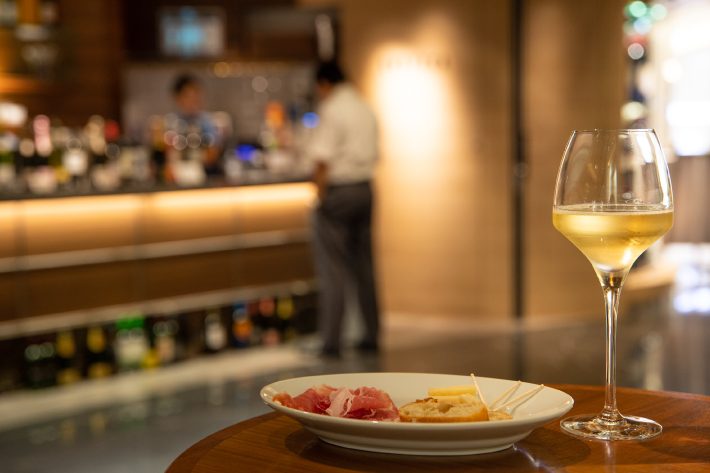
壁沿いのテーブル席が埋まっていたら、丸テーブルやカウンターでの立ち飲みでいい。その気負わぬ店構えを(良い意味で)裏切るワインの品質の高さが貴重なカフェ&バーだ。しっとり香りの良い生ハムとパルメザンチーズのおつまみもシンプル・イズ・ベスト。
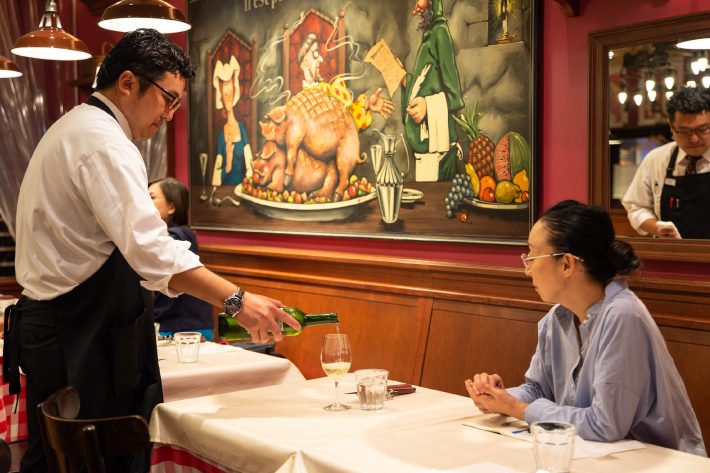
予約の気兼ねなしの1杯にこだわる(?)ならと、出かけたもう1軒は「ビストロ オザミ」。17時半から19時限定の「フレンチサク飲みメニュー」と、まさに望み通りのサービスのタイトルに惹かれて6階へ。
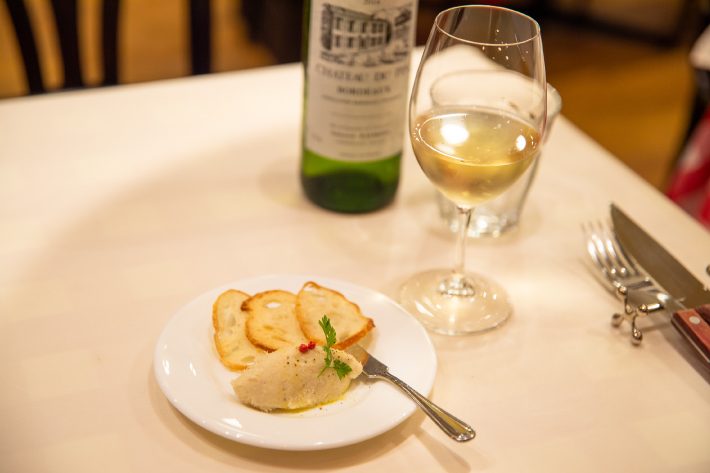
気さくなビストロの代名詞、赤白の格子のテーブルクロスの上に、さらに純白のクロスがかけられているから「やはり、ディナーの準備では?!」と疑ぐり深い私を他所に「サク飲みメニュー」から選んだ「白身魚のブランダード、メルバトースト添え」(600円 ※以下全て税抜価格)とグラスのボルドーの白「シャトー・デュ・パン」(500円)が運ばれる。
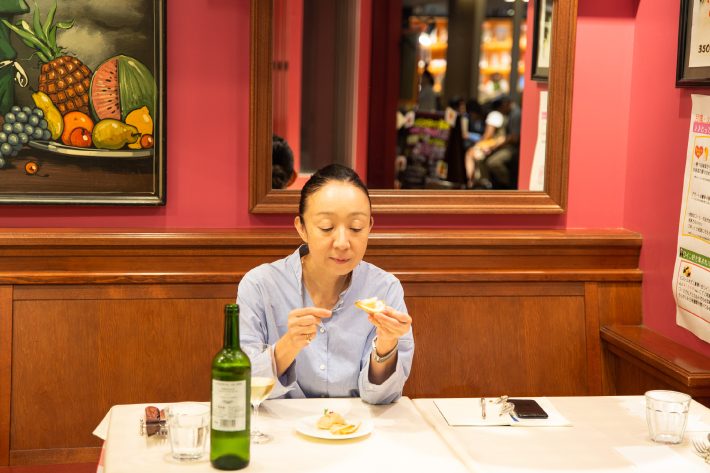
塩ダラを戻し、クリーミーに練るブランダードは、おつまみとはいえ手の込んだプロ仕事。軽い酸味のあるボルドーの白ワインをふっくら感じさせて、いい相性。一人静かにアペリティフ! のはずだったのに、仕事終わりの友人を呼んでここでディナーもいいかな、と様々思いを巡らせるのも自由な夕刻のお楽しみ。
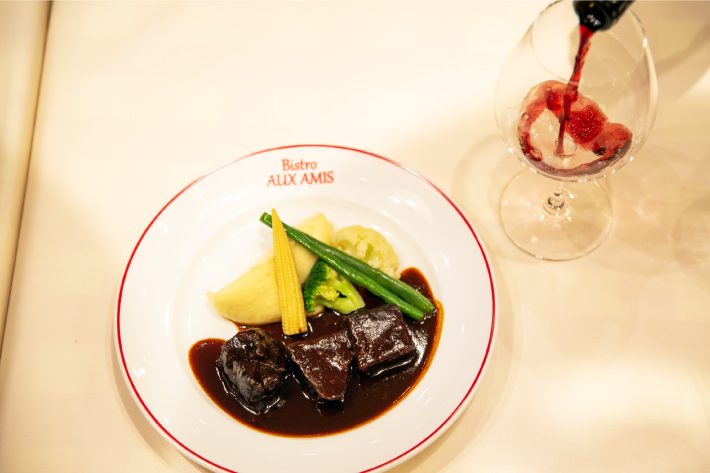
次回のディナーのロケハンに……と自分に言い聞かせ、アラカルトから「国産牛、ホホ肉の赤ワイン煮込み」(2,800円)を注文。ほろりと口溶けるホホ肉に絡む濃厚なソースにほんのり香るバターが食欲を誘う。常時6種を揃えるグラスの赤ワインから、料理の故郷ブルゴーニュの「コート・ド・ニュイ・ヴィラージュ」(1,200円)を添えて。

私のように「心変わり」してディナーに残るお客様にも、席に余裕があればすぐに対応してくれる「ビストロ オザミ」。本格的なビストロ料理とワインと快適なサービスがなんとも心憎い。
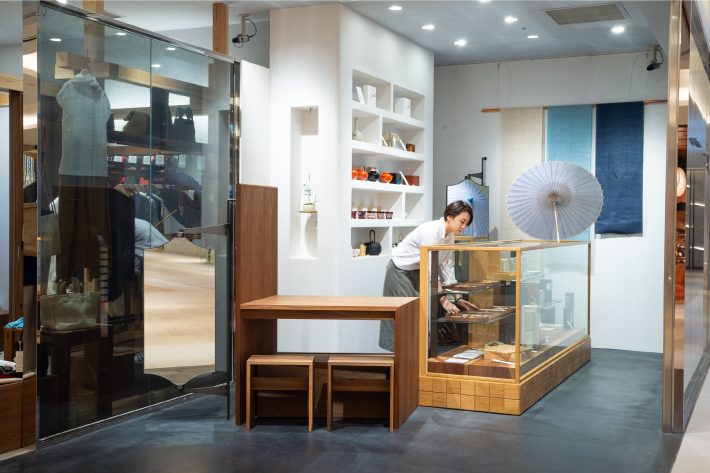
一方で、奈良で創業以来300年、工芸技術を活かした暮らしの道具を生み出してきた「中川政七商店」の店舗脇にある、日本の職人たちと協働する工芸品を展示するコーナーも訪れてみたい場所だった。現代の暮らしに生きる職人の手仕事とは?その意義と需要の模索は、今や国籍を問わぬクラフツマンシップの課題と長年感じてきたからだ。
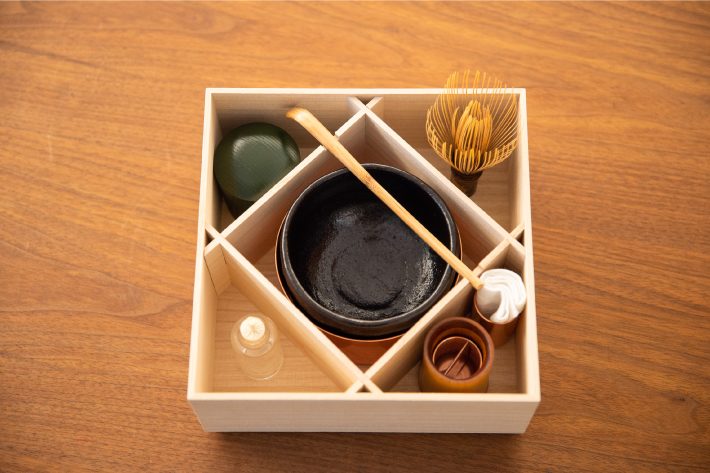
現在は、茶の湯をもっと家で気軽にと、正方形の桐の箱に基本の茶道具全てが収まるようにデザインした「家置きの茶道具箱」をメインに、新ブランド「茶論 見世」のポップアップ空間を展開する(8月1日~10月31日)。茶の湯の作法を学んでいてもいなくても、この箱を取り出せば気軽に一服楽しめるとは、確かにいいアイデア。茶碗から小棗、ガラス製の振出し、一輪挿し、茶巾筒など(個別売り)、コンパクトな佇まいは極めてモダン。
歩いて、時折休んで、また歩けば、昨日まで気づかなかった新しい何かに出会う銀座の散歩に、GINZA SIXは外せないコースになりそうだ。
Text : Chiyo Sagae Photos : Tomo Ishiwatari Edit : Yuka Okada
Tokyo should have more benches. That’s what I think each time I return to Japan, which is several times a year. To take a little break, to check where you’re going—the reasons vary. But sitting on a bench in an international city brings the rhythms and expressions of passersby into focus. A few moments of bench time give a detached perspectives on fragments of the city and its people. At the same time, these moments draw you closer to those passing by—it’s strange, actually. Benches are like small oases in a city where one is free to rest awhile, free of charge. So, why not, Tokyo?
My preamble has gone a bit longer than expected. What first struck me about GINZA SIX was the number of benches inside. You find wide leather benches with a touch of luxurious elegance in the hallways of each floor, most surrounding atrium space. You see couples discussing their shopping or an older woman taking a break. The impression is of a completely ordinary scene on what could be any street corner. I settle on one of the benches, lower my line of sight, and see how the hallways and shops stray from straight lines; how the corners of store blocks depart from rigid right angles; how the interior layout resembles the angles found on small side streets, inviting people to press on and discover. The appeal also lies in aspects like this.

The fun of walking GINZA SIX isn’t limited to benches. Another joyful find is “Like a flock of starlings: work in situ,” the art installation by French contemporary artist Daniel Buren that alighted in the central atrium space this past spring. I interviewed the artist previously in Paris. I remember the charming smile of a master, who winked when he said: “My starting point when I incorporate the characteristics of a place or space in my work is the Japanese idea of ‘borrowed scenery.’” Buren’s works characteristically allow viewers room to make their own discoveries, asking us, “So what do you see?” There’s no question his works present various when you look at them from different angles or directions.

The work in the atrium space consists of 1,675 red-and-blue triangular flags on a gigantic rectangular frame, installed at an angle. When you view the airy slope from a middle floor, it offers up something different than from a lower floor. Depending on your viewing position and angle, the overall sense of volume and the shape and ratio of red and blue all change and create a different impression. It’s fascinating.

Once, in France, I happened to see a formation of starlings in the countryside circling above a wide field. The movement of the flags, like a flock fluttering for a moment and expanding and contracting, makes me wonder if this is what it would look like if I could get up close and look from the sky. I picture this. I feel myself wanting to take a deep, deep breath in a wide-open space close to the sky. At times like this, I go up to GINZA SIX Garden, the rooftop garden and the pride of GINZA SIX.

A year has passed since GINZA SIX opened. It’s summer once again. The grass and the trees have taken firm root. The growth of trees and grass in the rooftop garden is thick and dense. Stone slabs have been spread, and water is flowing over them in the water feature, a popular play area for small children.

The central plaza opens to the sky. The promenade circling the expansive rooftop offers a view across the way to Ginza’s streets and buildings. A small path through the greenery appears at the corner of the plaza lined with trees and bushes of varying heights. You forget you’re on top of a building several tens of meters above the ground. Everyone spends their time exactly as they prefer for the passing moment in their favorite spots: walking, reading, eating lunch in the shade of the trees. The landscape artist Shunsaku Miyagi has said of his work here: “To seek to create a place not just for plants and trees, but for the sky, a place for people to come to breathe with a sense of vitality…” I’m in complete accord with the thoughtfulness of his design.

At the start of the Meiji period, around the 1870s, Ginza’s streets were said to be lined for the first time in Japan with trees native to the country, like cherry and maple. Given this historical backdrop, the rooftop garden is composed entirely of trees, plants, and flowers native to Japan. With the exception of gardens that are self-consciously “Japanese,” gardens composed entirely of native species are rare. I know relatively little about plants, but I’m interested in learning about each of the little flowers I see. In the photo, according to the sign, this is an Inumaki flower.

I notice the design of the benches. The area at your knees is comfortably curved, an appealing touch. The garden is filled with benches of the same design, but made of varying materials, like wood, gray granite, and stone of a certain mustard shade.

Another joy of a walk at GINZA SIX is the opportunity for evening aperitifs, should the fancy strike, as you sit in contemplation. Tokyo actually has very few privately run establishments where one feels totally free to drop in for a glass of wine in the evening, with no dinner reservation. I’ve lived many years in Paris: Every district has a million no-name cafés. I would often go to one and sit at the counter or out on the terrace, even if I had other plans for later in the evening. Suddenly longing for just such an unencumbered moment or two, I make my way to the café and bar at Wine Shop Enoteca on the second belowground floor.

The friendly atmosphere of the establishment is the first noteworthy impression. The hallway leading there is part of its interior space. Looking at the list of wines by the glass (including sparkling wine), I see a full seven varieties priced from 500 yen—also appealing. The list is updated every Wednesday, I’m told, as sommelier and wine selector Nobue Akasaka pours a dry sparkling wine (a Spanish Cava). Its profound effervescence and flavor lift my spirits.

If the tables along the wall are full, you can stand and drink at one of the round tables or at the counter. The elegance of the wine gainsays—in a good way—the casual interior and confers a special quality on this café and bar. Simple is best, argues the tender and fragrant dry-cured ham and parmesan cheese appetizer I find myself ordering.

If you prefer drinks without worrying about reservations, another destination is Bistro AUX AMIS. Limited items from the French Evening Drink Menu are offered from 5:30 p.m. to 7:00 p.m. Intrigued by the title of this service, which sounds like exactly what I want, I head to the sixth floor.

I see pure white cloths placed on the red-and-white checkered tablecloths, the classic visual welcome of the unpretentious bistro. I think for a moment, turning skeptical, that they’re of course preparing for dinner. But my selections from the Evening Drink Menu—the White Fish Brandade with Melba Toast (600 yen; all prices listed before tax) and glass of white Chateau du Pin Bordeaux (500 yen)—are graciously accepted and duly brought to my table.

Brandade is made by rehydrating salt cod and processing it into a thick cream. Technically, it’s an appetizer, but it’s the meticulous work of a professional. Against it the gentle tartness of the white Bordeaux is light and buoyant—the pairing works well. A quiet aperitif alone! That was the plan. But I find myself thinking all sorts of things…maybe I’ll invite a friend who’s done with work for the day to have dinner with me here. Being free to think all sorts of things is one of the joys of evening.

I tell myself I’m simply location scouting for my next dinner and order the Japanese Beef Cheeks in Red Wine Sauce (2,800 yen) from the à la carte menu. The faintly aromatic butter in the rich sauce over meltingly tender beef cheeks piques the appetite. Six varieties of red wine by the glass are typically on offer. I choose the Côte de Nuits-Villages (1,200 yen) from Burgundy, the home of this dish.

If there’s space, Bistro AUX AMIS immediately accommodates patrons, like me, who have a change of heart and decide to stay for dinner. Authentic bistro food, wine, and pleasant service—perfect!

One of the places I’ve wanted to visit is a space displaying handicrafts made in collaboration with Japanese craftspeople in the corner of Nakagawa Masashichi Shoten, which, since its founding 300 years ago in Nara, has applied craft techniques to produce implements for daily life. This is based in part on feeling for many years that the significance of handicrafts made by craftspeople living in contemporary society, and the effort to connect these craftspeople to consumers who appreciate their work, are issues of craftsmanship transcending nationality.

The store currently features pop-up space (August 1 to October 31) for the new brand Saron Mise, known best for making tea utensil boxes for the home, designed to store all the basic tea utensils in a square, paulownia wood box. Even if you’re not studying tea ceremony formally, bringing out this box and enjoying a little tea break is certainly a fine idea. From a tea cup to a small tea caddy, glass candy container, single-flower vase, tea cloth case, and more—all sold separately—the impression created by the compact dimensions couldn’t be more modern.
Walk and rest from time to time, then walk again. If you do, you’ll find something new you didn’t notice the day before. For a quiet walk in Ginza, you can’t go wrong with a route through GINZA SIX.
Text : Chiyo Sagae Photos : Tomo Ishiwatari Edit : Yuka Okada
寒河江 千代
ジャーナリスト。文化・表現社会学を専攻しながらTV、新聞社の制作アシスタントを経て1986年より渡仏。食、建築デザイン、旅を中心に「カーサブルータス」「ブルータス」「料理通信」他で取材・執筆。昨年より「Hanako旅ムック」の編集に携わり、エディター修行中。


